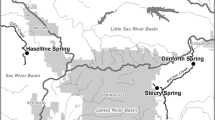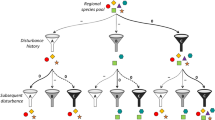Summary
We examined the importance of disturbance in determining the relative abundances of two lotic filter-feeders, Simulium virgatum and Hydropsyche oslari, in a small, coastal stream in southern California, USA.
In most years, winter spates effectively scour substrata in fast-flowing areas, thereby drastically reducing stream insect populations. Newly-opened space in these areas is quickly colonized by simuliids. The abundance of simuliids, however, gradually declines as hydropsychid abundance increases in early summer. To determine if these changes in insect abundance represent seasonal changes or successional changes following disturbance, we performed a field experiment where hard substrates were disturbed at 2 wk, 4 wk, or 8 wk intervals, or were left undisturbed. We found that the numbers of simuliids increased and the numbers of hydropsychids decreased as the frequency of disturbance increased. Although seasonal recruitment patterns and longitudinal position in the strem had important effects on the colonization rates of these insects, time since last disturbance was a prime determinant of the relative abundances of Simulium and Hydropsyche. These results and additional observations suggest that Simulium virgatum is an opportunistic species that quickly colonizes new space, but that it is displaced by the slower-colonizing but competitively superior Hydropsyche oslari. Disturbance promotes the coexistence of these two species by preventing the attainment of a climax state where Hydropsyche monopolizes available space.
Similar content being viewed by others
References
Allan JD (1975) The distributional ecology and diversity of benthic insects in Cement Creek, Colorado. Ecology 55:1040–1053
Burton GJ, TM McRae (1972) Observations on trichopteran predation on the aquatic stages of Simulium damnosum and other Simulium in Ghana. J Med Entomol 9:289–295
Chutter FM (1968) On the ecology of the fauna of stones in the current in a South African river supporting a very large Simulium population. J Appl Ecol 5:531–561
Connell JH (1978) Diversity in tropical rain forests and coral reefs. Science 199:1302–1310
Dayton PK (1971) Competition, disturbance, and community organization: the provision and subsequent utilization of space in a rocky intertidal community. Ecol Monogr 41:351–389
Denslow JS (1980) Patterns of plant species diversity during succession under different disturbance regimes. Oecologia (Berlin) 46:18–21
Dix RL, JMA Swan (1971) The role of disturbance and succession in upland forest at Candle Lake, Saskatchewan. Can J Bot 49:657–676
Fisher SG, LJ Gray, NB Grimm, DE Busch (1982) Temporal succession in a desert stream ecosystem following flash flooding. Ecol Monogr 52(1):93–110
Fox LR (1975) Some demographic consequences of food shortage for the predator Notonecta hoffmanni. Ecology 56:868–880
Fuller RL, RJ Mackay (1980) Feeding ecology/of three species of Hydropsyche (Trichoptera: Hydropsychidae) in southern Ontario. Can J Zool 58:2239–2251
Hanes TL (1971) Succession after fire in the chaparral of southern California. Ecol Monogr 41:27–52
Harrison AD (1958) Hydrobiological studies on the Great Berg River, Western Cape Provice. Part 2. Quantitative studies on sandy bottoms, notes on tributaries and further information on the fauna, arranged systematically. Trans R Soc S Afr 35:227–276
Helwig JT, KA Council (1979) Statistical analysis system user's guide. Statistical Analysis System Institute, Raleigh, North Carolina, USA
Hynes HBN, TR Williams (1962) The effect of DDT on the fauna of a Central African stream. Ann Trop Med Parasitol 56:78–91
Kaminsky R (1981) The microbial origin of the allelopathic potential of Adenostoma fasciculatum H & A. Ecol Monogr 51:365–382
Kay AM, MJ Keough (1981) Occupation of patches in the epifaunal communities on pier pillings and the bivalve Pinna bicolor at Edithburgh, South Australia. Oecologia (Berlin) 48:123–130
Menge BA (1976) Organization of the New England rocky intertidal community: role of predation, competition, and environmental heterogeneity. Ecol Monogr 46:355–393
Merritt RW, JB Wallace (1981) Filter-feeding insects. Sci Am 244(4):132–144
Parsons DJ (1976) The role of fire in natural communities: an example from the sourthern Sierra Nevada, California. Env Consrv 3:91–99
Paine RT, SA Levin (1981) Intertidal landscapes: disturbance and the dynamics of pattern. Ecol Monogr 51 (2):145–178
Pavlichenko VI (1977) Role of larvae of Hydropsyche angustipennis Curt. (Trichoptera, Hydropsychidae) in the destruction of blackfly larvae in running water of Zaporozhe Oblast. Sov J Ecol (Engl Trans Ékologiya) 8(1):84–85
Petersen BV (1960) Notes on some natural enemies of Utah blackflies. Can Entomol 92:266–274
Peterson BV, DM Davies (1960) Observations on some insect predators of black flies (Diptera: Simuliidae) of Algonquin Park, Ontario. Can J Zool 38:9–18
Purdie RW, RO Slatyer (1976) Vegetation succession after fire in sclerophyll woodland communities in south-eastern Australia. Aust J Ecol 1:223–236
Siegfried CA, AW Knight (1977) The effects of washout in a Sierra foothill stream. Am Midl Nat 98:200–206
Sousa WP (1979a) Experimental investigations of disturbance and ecological succession in a rocky intertidal algal community. Ecol Monogr 49:227–254
Sousa WP (1979b) Disturbance in marine intertidal boulder fields: the non-equilibrium maintenance of species diversity. Ecology 60:1225–1239
Sousa WP (1980) The responses of a community to disturbance: the importance of successional age and species' life histories. Oecologia (Brlin) 45:72–81
Sprugel DG, FH Borman (1980) Natural disturbance and the steady state in high-altitude balsam fir forests. Science 211:390–393
Stout RJ (1982) Effects of a harsh environment on the life history patterns of two species of tropical aquatic Hemiptera (Family: Naucoridae). Ecology 63:75–83
Sutherland JP (1974) Multiple stable points in natural communities. Am Nat 108:859–873
Sutherland JP (1981) The fouling community at Beaufort, North Carolina: a study in stability. Am Nat 118:488–498
Turner T (1982) Community organization and succession in rocky intertidal surfgrass beds. Ph.D. thesis. Oregon State University
Ulfstrand S, LM Nilsson, A Stergar (1974) Composition and diversity of benthic species collectives colonizing implanted substrates in a south Swedish stream. Entomol Scand 5:115–122
Wallace JB, RW Merritt (1980) Filter-feeding ecology of aquatic insects. Ann Rev Entomol 25:103–132
Wiley MJ, SL Kohler (1981) An assessment of biological interactions in an epilithic stream community using time lapse cinematography. Hydrobiol 75:183–188
Author information
Authors and Affiliations
Rights and permissions
About this article
Cite this article
Hemphill, N., Cooper, S.D. The effect of physical disturbance on the relative abundances of two filter-feeding insects in a small stream. Oecologia 58, 378–382 (1983). https://doi.org/10.1007/BF00385239
Received:
Issue Date:
DOI: https://doi.org/10.1007/BF00385239




